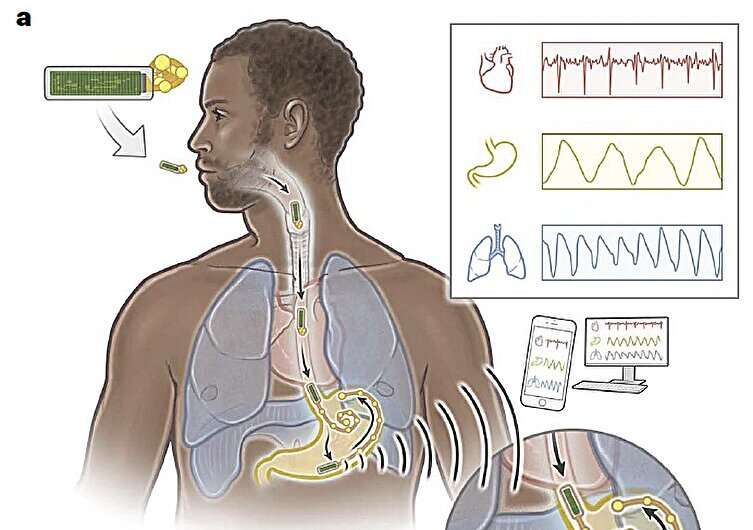June 17, 2024 feature
This article has been reviewed according to Science X's editorial process and policies. Editors have highlighted the following attributes while ensuring the content's credibility:
fact-checked
peer-reviewed publication
trusted source
proofread
An ingestible device to record gastric electrophysiological activity

Recent technological advancements have enabled the development of new cutting-edge medical devices, including surgical robots, sensors that can monitor physiological processes and VR platforms to train doctors. A long-standing goal for medical technology engineers is to also create devices that can be ingested or otherwise inserted within the human body to observe or track the activity of specific organs.
Researchers at Massachusetts Institute of Technology (MIT) and Harvard Medical School recently developed a new ingestible device that could be used to record electrophysiological signals in users' gastrointestinal tracts. This device, introduced in a paper published in Nature Electronics, could help doctors to safely diagnose and monitor the progression of disorders affecting the digestion of food and liquids.
"The ability to record high-quality electrophysiology data from the gastrointestinal tract and enteric nervous system is of use in understanding a variety of disorders and improving health care via early diagnosis," Siheng Sean You, Adam Gierlach and their colleagues wrote in their paper.
"However, such measurements remain challenging because electrodes must be implanted surgically or worn on the skin, which results in a trade-off between signal quality and invasiveness. We report an ingestible device for gastric electrophysiology."
The enteric nervous system (ENS), one of the three key divisions of the autonomic nervous system, is comprised of millions of neurons and cells regulating the secretion of hormones in the gastrointestinal tract. Many disorders of the gastrointestinal tract, including gastroparesis and functional dyspepsia, are associated with dysfunctions in these neurons' electrical signaling.
Reliably tracking the electrical signaling of cells in the gastrointestinal track could thus help doctors to diagnose various disorders, better understand their underpinnings and devise personalized treatment strategies. The ingestible device developed by You, Gierlach and their colleagues can record these electrical signals and send them to a receiver outside of a patient's body.
The device developed by the team consists of an electronic module and various flexible measurement electrodes, contained inside a 3D-printed case that looks like a capsule or pill. This case, along with the electrodes, are all made of biocompatible materials that should be safe to introduce within the human body.
"The non-invasive system, which is termed multimodal electrophysiology via ingestible, gastric, untethered tracking (MiGUT), consists of encapsulated electronics and a sensing electrode ribbon that unrolls in the stomach following delivery to make contact with the mucosa," You, Gierlach and their colleagues wrote.
"The vc device then records and wirelessly transmits biopotential signals to an external receiver. We show that the device can record electrical signals—including the gastric slow wave, respiration signal and heart signal—in a large animal model and can monitor slow wave activity in freely moving and feeding animals."
You, Gierlach and their colleagues have so far evaluated their device by inserting it in anesthetized pigs and then collecting measurements when the pig woke up and started moving again.
Their findings were highly promising, suggesting that the device can be safely introduced inside a living animal and can record high-quality electrical signals of its gastric environment.
The device could soon be evaluated further in additional animal tests and eventually in human clinical trials. In the future, its development could open new avenues for medical research and practices, while also potentially informing the development of other ingestible medical devices.
More information: Siheng Sean You et al, An ingestible device for gastric electrophysiology, Nature Electronics (2024). DOI: 10.1038/s41928-024-01160-w
© 2024 Science X Network



















